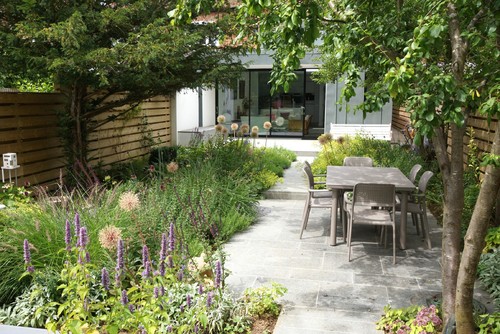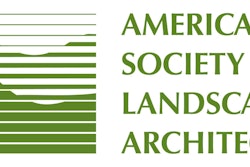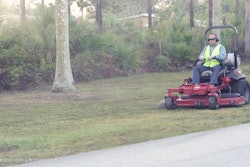A meadow brings the gifts of untamed nature to a garden: a sweep of grasses swaying in the wind evokes the rippling expanse of the open ocean; a freckling of wildflowers in varied colors and shapes delights with ever-changing beauty. Well-designed meadows can enhance any style of landscape, and they provide important habitats for wildlife, especially pollinators and songbirds.
Best of all, your customers can get many of the benefits of a meadow even if they don’t have acres of land. All you need is an understanding of what makes a successful meadow, a place to plant and an appreciation for serendipity (I’m using the term “meadow” here to also include prairie gardens. The distinction between the two isn’t clear).
What makes a meadow? A meadow is a plant community defined by grasses, not just an unmowed lawn. A meadow typically emphasizes plants native to the area, and it includes many types of grasses and grasslike plants, plus wildflowers and low shrubs. Unlike a lawn, a meadow isn’t regularly mowed or cut back, except for a yearly trim (usually in spring). This gives it a natural look and allows plants to go to seed and provide food and shelter for wildlife.
A small meadow can fit almost anywhere. It can be a focal point in a lawn area; a wide border along a fence, patio or walk; a patch of tall native grasses concealing an air-conditioning unit; even a bunch of pots with grasses waving next to flowers that attract pollinators and hummingbirds.
Note: Before planning a meadow, even a small one, check your local landscaping ordinances and homeowners association regulations to make sure that the meadow doesn’t violate any height or maintenance requirements.
 Photo: Susan J. Tweit
Photo: Susan J. TweitDesigning a meadow
What kind of meadow does your customer imagine? The composition of a meadow depends partly on their taste. Do they prefer mostly grasses and grasslike plants? A combination of grasses and wildflowers? Shrubs for accents? Meadow composition also depends on what will thrive in their site. Plants adapted to the climate, soil and topography will establish more readily and require less attention to succeed.
The most pleasing and long-lived meadow plantings generally reflect the terroir, or flavor of place. They feature native species and are designed to echo the regional look of nearby grasslands, prairies or shrublands.
The meadow in this photo is a prairie at Denver Botanic Gardens, showcasing species native to Colorado’s western Great Plains. In this fall photo above, the grasses and subshrubs, including the lovely rust-colored switchgrass (Panicum virgatum) and silvery-green white sagebrush (Artemisia ludoviciana), are most prominent. In spring and summer, the wildflowers appear dominant. The purple flower spikes are Rocky Mountain blazing star (Liatris ligulistylis), the last wildflower of the season.
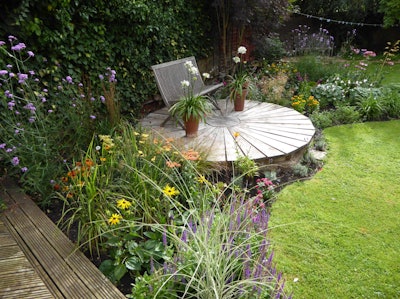 Photo: Yorkshire Garden Designer
Photo: Yorkshire Garden DesignerLook at your client’s landscape with a meadow in mind. Where would they like to see grasses waving in the breeze? Where could butterflies and hummingbirds flit and hover undisturbed? Do they have an unused corner or something that a meadow could conceal?
- For a focal-point meadow, draw a circle or your preferred shape in an area of the yard that will be visible from all angles. The diameter of the circle or width of the other shape should be at least 5 to 6 feet for a full meadow effect.
- A meadow also can replace a wide border or give presence to an underused corner. Randomly scatter a seed mix of native grasses and wildflowers for a strip of prairie-type border. For a more formal border, plant short grasses or low sedges in front and work upward to the tallest grasses and shrubs in the back.
- Plant a swath of meadow at the far end of a small yard to give the effect of a distant prospect.
Formal. Meadows also fit in more formal landscaping schemes. The meadow in this photo, for instance, provides a charming swath of blue in spring to a Montana slope between formal garden areas. The blue comes from native Lewis flax (Linum lewisii), backed by two species of native bunch grasses: blue grama (Bouteloua gracilis) and midheight Indian ricegrass (Achnatherum hymenoides). One way to achieve a more formal meadow look is to use fewer species and a narrower color palette, as shown here. You also can use a selection of sedges, all about the same height and texture, with some variation in color over the seasons.
Or you can deliberately place the plants in a more formal arrangement. For example, a formal Colorado meadow-style border could include a swath of a shortgrass like buffalograss (Buchloe dactyloides) in front, backed by a band of purple poppy mallow (Callirhoe involucrata), a band of midheight sideoats grama(Bouteloua curtipendula), then butterfly milkweed (Asclepias tuberosa) and a tall “spine” of Maximilian sunflower (Helianthus maximiliani).
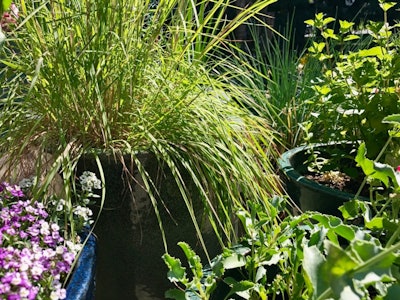 Photo: Susan J. Tweit
Photo: Susan J. TweitMini. If your customer’s yard is a terrace, balcony or patio, you can still plant a little meadow. Group as many medium to large pots as the space will accommodate, and plant them with meadow species. Place the pots where the mini meadow will have maximum impact, whether it serves as a screen or a focal point, and then enjoy.
The little meadow in this photo lives on a south-facing front entry patio in Wyoming. It includes midheight little bluestem (Schizachyrium scoparium); shorter Idaho fescue (Festuca idahoensis), with wire-thin, bluish leaves; Sunset crater beardtongue (Penstemon clutei); gaura (Gaura lindheimeri); and nonnative annual sweet alyssum (Lobularia maritima), which feeds early-flying pollinators before the native wildflowers begin to bloom.
If your customer has room for six pots in their outdoor space, for example, plant half with grasses or grasslike plants, and cluster those together for maximum meadow-like effect — grasses waving in the wind. One pot could hold a tall grass, and two could contain a midheight grass or grasslike plant (pick species that will provide different colors and textures). Then plant a small shrub or subshrub in one pot with a taller wildflower, plus two containers with flowers, preferably ones that appeal to pollinators and bloom at different times in the season.
Planting
Meadows can be created either by arranging potted plants in a naturalistic way or by seeding. Whichever method you use, if the meadow site will replace existing lawn, either smother the turfgrass by covering it with layers of cardboard (weighted with rocks or boards) for several months or cut out the turf, and plant the meadow.
From pots. Starting with potted plants works well in very small places and gives you more design control, since you can place each plant for maximum effect. For a natural look, avoid putting plants in straight lines; instead, group them by threes or fives, and stagger the groupings for a random appearance.
From seed. For larger spaces or a more random look, seeding your meadow area is the way to go. It’s also considerably cheaper. You can always plug in potted plants later for more color, blooms or additional species or varieties.
Prepare for seeding in the same way you would for planting, especially if the meadow is replacing existing turfgrass. It is imperative that any existing turf be killed, or else you will constantly have to weed lawn grasses out of the meadow to keep them from taking over.
Meadow mixes are widely available at nurseries and online; however, many include species that aren’t native or are aggressive. A plant labeled a “wildflower” is not necessarily either native or desirable. For example, many meadow mixes contain bachelor’s button, a European native that can be a nuisance, and Shasta daisy, also native to Europe, which is now considered a noxious weed in parts of the West.
Before you buy a meadow mix, read the label carefully and check for invasive or undesirable species. Local cooperative extension offices can help you learn which species are invasive; most states also maintain lists of invasives online.
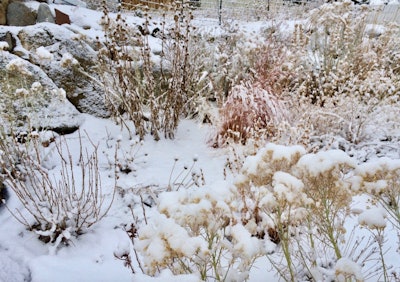 Photo: Susan J. Tweit
Photo: Susan J. TweitChoosing plants
Seasonal Interest. When selecting plants or a seed mix, consider how your client’s meadow will look in different seasons. In a small space, it’s especially important to include plants that offer interest and provide habitat year-round. Look for plants that green up and flower early; that enliven even the “dog days” of late summer, when many plants look tired from the heat; and that provide color in the fall.
Don’t forget plants with architectural form for winter. Using shrubs, taller grasses and sturdier flowers gives a meadow presence, even when snow may flatten finer-textured grasses and more delicate wildflowers. Plants that stand up to winter also provide habitat for wildlife, both food and shelter, which is one reason not to tidy a meadow until spring and regrowth begin. Leaving the dried stalks intact over the winter makes for good meadow habitat, especially for native bees and songbirds.
In this garden, the plants that stand out — and stand up — under snow are the midheight and tall grasses, including little bluestem (Schizachyrium scoparium), the orange clump of grass; rubber rabbitbrush (Ericameria nauseosa); and Maximilian sunflower (Helianthus maximiliani), with the latter two retaining their dried flower heads for winter interest.
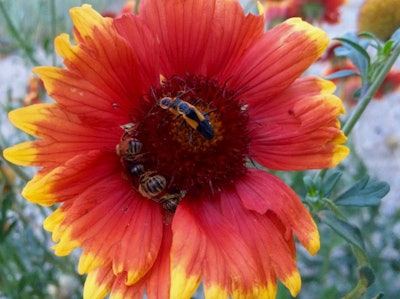 Photo: Susan J. Tweit
Photo: Susan J. TweitPollinators and other beneficial wildlife. Don’t forget pollinators and other wildlife when selecting plants or a seed mix for your customer’s small meadow. Make sure to choose plants that will provide food and shelter for the “little guys who really run the world,” as biologist E.O. Wilson puts it.
The Indian blanket (Gaillardia pulchella) in this photo is an example of a super-habitat plant perfect for small meadows because it offers beauty and multiple benefits. It is attractive to a wide variety of pollinators, including beetles and native bees. Its seeds also feed goldfinches, siskins, house finches and other small songbirds. And it’s a long-flowering native wildflower that flourishes in meadow plantings and is not attractive to deer or rabbits.
Even if the meadow is all grass and grasslike plants, for instance, they will provide seed for songbirds. And you can foster butterflies by selecting native grasses that feed butterfly caterpillars. Caterpillars are the ultimate picky eaters, as the precipitous decline of monarch butterflies illustrates.
Monarch caterpillars eat only milkweed plants, more specifically milkweeds native to North America. Plowing up prairie for farm fields and spraying roadsides with herbicides nearly decimated milkweed populations, and thus monarch butterflies. As milkweeds are being replaced, monarchs are returning.
Good sources for information on what pollinators use which plants include butterfly field guides, like Robert Michael Pyle’s The Audubon Society Field Guide to Butterflies, with an index to pollinator plants, and The Xerces Society’s Attracting Native Pollinators.
EDITOR’S NOTE: This article is from Houzz and was written by Susan Tweit. Tweit is a plant biologist, award-winning writer and speaker and landscape/garden consultant focusing on restoring nature and habitat for songbirds and pollinators.
